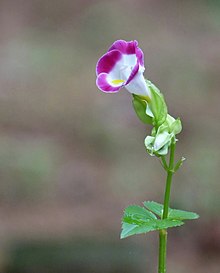Superasterids
Appearance
| Superasterids Temporal range:
| |
|---|---|

| |
| Torenia fournieri | |
| Scientific classification | |
| Kingdom: | Plantae |
| Clade: | Tracheophytes |
| Clade: | Angiosperms |
| Clade: | Eudicots |
| Clade: | Core eudicots |
| Clade: | Superasterids |
| Clades[1] | |
The superasterids are members of a large clade (monophyletic group) of flowering plants, containing more than 122,000 species.
The clade is divided into 20 orders as defined in APG IV system. These orders, in turn, together comprise about 146 families.[1]
The name is based upon the name "Asteridae", which had usually been understood to be a subclass.
Relationships
The asterids, Berberidopsidales, Santalales, and Caryophyllales form the superasterids clade.[2] This is one of three groups that compose the Pentapetalae (core eudicots minus Gunnerales),[3] the others being Dilleniales and the superrosids (Saxifragales and rosids).[2]
Phylogeny
The phylogeny of superasterids shown below is adapted from the Angiosperm Phylogeny Group website.[2]
| superasterids | |
References
- ^ a b Angiosperm Phylogeny Group (2016). "An update of the Angiosperm Phylogeny Group classification for the orders and families of flowering plants: APG IV". Botanical Journal of the Linnean Society. 181 (1): 1–20. doi:10.1111/boj.12385.
- ^ a b c Peter F. Stevens (2001), Angiosperm Phylogeny Website
- ^ Philip D. Cantino; James A. Doyle; Sean W. Graham; Walter S. Judd; Richard G. Olmstead; Douglas E. Soltis; Pamela S. Soltis & Michael J. Donoghue (2007), "Towards a phylogenetic nomenclature of Tracheophyta" (PDF), Taxon, 56 (3): 822–846, doi:10.2307/25065865, JSTOR 25065865
External links
 Media related to Superasterids at Wikimedia Commons
Media related to Superasterids at Wikimedia Commons

